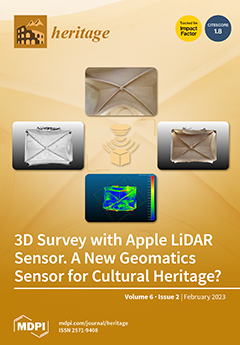This paper discusses colorants found in Tumulus MM, the tomb of King Midas or his father, at Gordion, the capital of the Phrygian kingdom. Chromophores, colorants, and auxiliaries are preserved largely independent of the textiles they once colored. The Tumulus MM textiles are
[...] Read more.
This paper discusses colorants found in Tumulus MM, the tomb of King Midas or his father, at Gordion, the capital of the Phrygian kingdom. Chromophores, colorants, and auxiliaries are preserved largely independent of the textiles they once colored. The Tumulus MM textiles are now fragmentary due to the degradation processes that occurred inside the tomb chamber. For DHA 26 (Vienna, Austria, 2007), we discussed a group of golden-yellow fragments from Tumulus MM that appeared to be tabby cloth but were skeletal lattices of goethite, αFeOOH (yellow ochre), as identified by FTIR, with SEM/EDS, XRD with molybdenum Kα radiation, NIR, and Raman spectroscopy. The “dyeing” has been replicated using a patented method; originally it may have involved a controlled redox reaction, based on our preliminary experiments. Amidst the goethite lattices, some skeletal fragments were green, with near-black lines within the yarn spiral, identified as indigo by FTIR at the time. Other masses with colorations of red, orange/brown, and purple with deep red veins did not yield identifiable inorganic coloration profiles with SEM/EDS. A purple fragment (2003-Tx-6 Front) was assayed by ICP-MS for mordants and for bromine, but neither could be found. Recently, direct analysis in real time mass spectrometry (DART-MS) enabled us to successfully detect organic colorants. For one fragment, indoxyl, isatin, indigo, and
leuco-indigo were identified. One striated red-to-brown mass (2003-Tx-3) contained alizarin, purpurin, xanthopurpurin, lucidin, and other madder substituents; it also contained indigo/isatin but neither indoxyl nor
leuco-indigo. Other beige-brown masses like 2003-Tx-5 sometimes contained alizarin, xanthopurpurin, rubiadin, and lucidin but rarely purpurin or indigo-related compounds. The purple (2003-Tx-6) shared the madder analogues with browner hues. The versatility appears related to that found in Anatolian pile carpets and flat weaves. Our new analyses confirm that the Phrygian textile colorists were indeed superb, versatile dyers.
Full article





